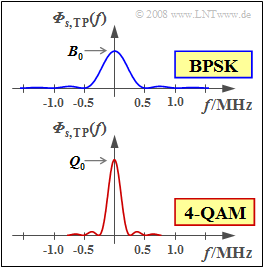Exercise 4.11: Frequency Domain Consideration of the 4-QAM
Taking as our starting point BPSK (binary phase modulation) with a rectangular fundamental pulse $g_s(t)$ of width $T_{\rm B} = 1 \ \rm µ s$ and amplitude $s_0 = 2 \ \rm V$ , this exercise aims to determine the power density spectrum (LDS) of the 4–QAM step by step.
In Exercise 4.7 power-spectral density ${\it Φ}_s(f)$ of the BPSK was determined for exactly these parameter values. Using
- $$A = s_0^2 \cdot T_{\rm B} = 4 \cdot 10^{-6}\,{\rm V^2/Hz}$$
one obtains an actual power-spectral density (in the bandpass range) of:
- $${{\it \Phi}_s(f)} = {A}/{4} \cdot {\big [ {\rm si}^2(\pi \cdot T_{\rm B}\cdot (f - f_{\rm T})) + {\rm si}^2(\pi \cdot T_{\rm B}\cdot (f + f_{\rm T}))\big ]}\hspace{0.05cm}.$$
However, the top graph shows the power-spectral density ${{\it \Phi}_{s, \hspace{0.05cm}\rm TP}(f)}$ of the equivalent low-pass signal. This is obtained from ${\it Φ}_s(f)$ by
- Truncating all components at negative frequencies,
- Quadrupling the components at positive frequencies
- (note: a spectrum must be doubled, a power-spectral density quadrupled), and
- Shifting by $f_{\rm T}$ to the left:
- $${{\it \Phi}_{s, \hspace{0.05cm}\rm TP}(f)} = A \cdot {\rm si}^2(\pi f T_{\rm B}). \hspace{0.2cm}$$
4–QAM differs from BPSK regarding the following details:
- Splitting the binary source signal into two partial signals, each with half the bit rate, that is, with symbol duration $T = 2 · T_{\rm B}$.
- Multiplication of the partial signals with cosine and minus-sine, whose amplitudes $g_0$ are each smaller than $s_0$ by a factor of $\sqrt{2}$ .
- Summation of the two partial signals denoted by $s_{\cos}(t)$ nd $s_{–\sin}(t)$ :
- $$s(t) = s_{\rm cos}(t)+ s_{\rm -sin}(t) \hspace{0.05cm}.$$
Hints:
- This exercise belongs to the chapter Quadrature Amplitude Modulation.
- Reference is also made to the page BPSK – Binary Phase Shift Keying in the previous chapter.
- The power-spectral density (PSD) of a QAM component is identical to the comparable BPSK PSD:
- Energies are to be specified in $\rm V^2s$ ; they thus refer to the reference resistance $R = 1 \ \rm \Omega$.
Questions
Solution
- If one integrates over the equivalent low-pass PSD, the factor $1/2$ must still be taken into account:
- $$P_{\rm BPSK} = \int_{ - \infty }^{+\infty} {{\it \Phi}_{s}(f)}\hspace{0.1cm} {\rm d}f = \frac{1}{2} \cdot \int_{ - \infty }^{+\infty} {{\it \Phi}_{s, \hspace{0.05cm}\rm TP}(f)}\hspace{0.1cm} {\rm d}f = \frac{A}{2} \cdot \int_{ - \infty }^{+\infty} {\rm si}^2(\pi f T_{\rm B})\hspace{0.1cm} {\rm d}f = \frac{A}{2T_{\rm B}} \cdot \int_{ - \infty }^{+\infty} {\rm si}^2(\pi x)\hspace{0.1cm} {\rm d}x =\frac{A}{2T_{\rm B}}$$
- $$\text{Mit} \ \ A = 4 \cdot 10^{-6}\,{\rm V^2/Hz}\hspace{0.05cm}, \hspace{0.2cm} T_{\rm B}= 10^{-6}\,{\rm s} \hspace{0.3cm}\Rightarrow \hspace{0.3cm} P_{\rm BPSK} = 2\,{\rm V^2} ( = {s_0^2 }/{2})\hspace{0.05cm}.$$
- Accordingly, the energy per bit is for BPSK:
- $$E_{\rm B} = {P_{\rm BPSK} \cdot T_{\rm B}}\hspace{0.15cm}\underline {= 2 \cdot 10^{-6}\,{\rm V^2/Hz}}\hspace{0.05cm}.$$
- Here again, the reference resistance is$1\ \rm Ω$.
(2) Due to the double symbol duration of 4-QAM $(T = 2 · T_{\rm B})$ , the spectral function is only half as wide as compared to BPSK, but twice as high, and instead of $s_0$ , the smaller value $g_0$ must now be considered.
- The PSD value at frequency $f = 0$ is thus:
- $${\it \Phi}_{s, \hspace{0.05cm}\rm cos,\hspace{0.05cm}\rm TP}(f = 0 ) = \left ({s_0}/{\sqrt{2}} \right )^2 \cdot 2 \cdot T_{\rm B} ={s_0^2 \cdot T_{\rm B}} = B_0 \hspace{0.05cm}.$$
- Therefore, the result is exactly the same value as for BPSK:
- $$B_0 = {\it \Phi}_{s, \hspace{0.05cm}\rm cos,\hspace{0.05cm}\rm TP}(f = 0 ) \hspace{0.15cm}\underline {= 4 \cdot 10^{-6}\,{\rm V^2/Hz}}$$
(3) The second partial signal $s_{–\sin}(t)$ yields exactly the same contribution as the signal $s_{\cos}(t)$ just considered.
- Due to the orthogonality between the cosine and the minus-sine functions, the powers can be added and we get:
- $$Q_0 = {\it \Phi}_{s, \hspace{0.05cm}\rm TP}(f = 0 ) = 2 \cdot B_0 \hspace{0.15cm}\underline {= 8 \cdot 10^{-6}\,{\rm V^2/Hz}}\hspace{0.05cm}.$$
(4) Analogously to in question (1) we get an energy per bit of:
- $$E_{\rm B} = \frac{1}{2} \cdot T_{\rm B} \cdot \int_{ - \infty }^{+\infty} {{\it \Phi}_{s, \hspace{0.05cm}\rm TP}(f)}\hspace{0.1cm} {\rm d}f = \frac{Q_0 \cdot T_{\rm B}}{2T} \cdot \int_{ - \infty }^{+\infty} {\rm si}^2(\pi f T_{\rm B})\hspace{0.1cm} {\rm d}f = \frac{Q_0 \cdot T_{\rm B}}{2T} = \frac{8 \cdot 10^{-6}\,{\rm V^2/Hz} \cdot 1\,{\rm \mu s}}{ 2 \cdot 2\,{\rm \mu s}}\hspace{0.15cm}\underline {= 2 \cdot 10^{-6}\,{\rm V^2/Hz}}\hspace{0.05cm}.$$
- It can be seen that with the assumptions made here, the "energy per bit" of BPSK and 4-QAM coincide.
